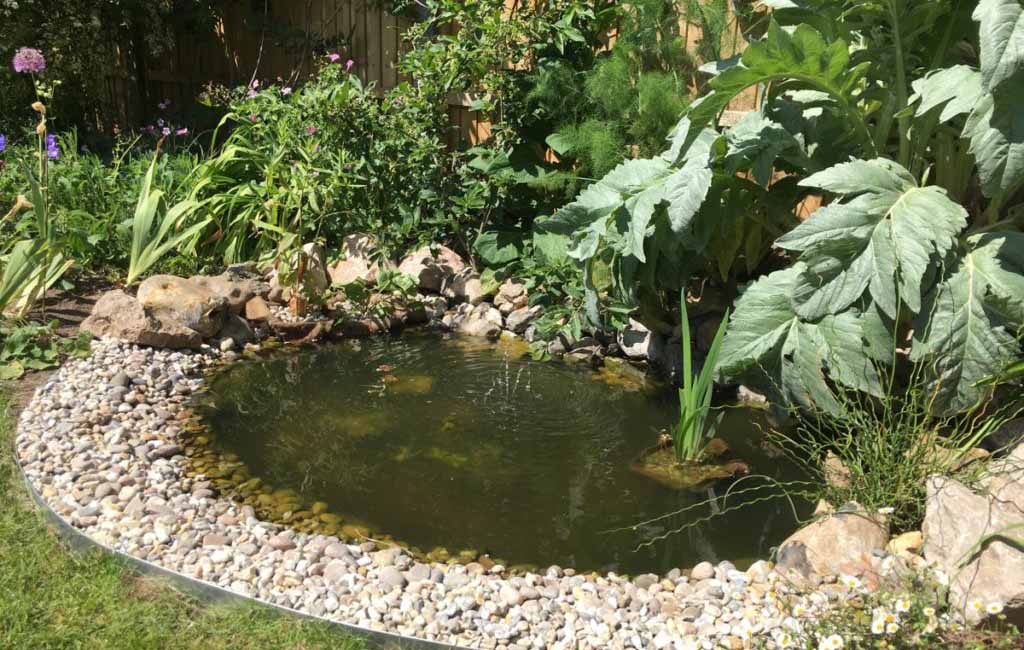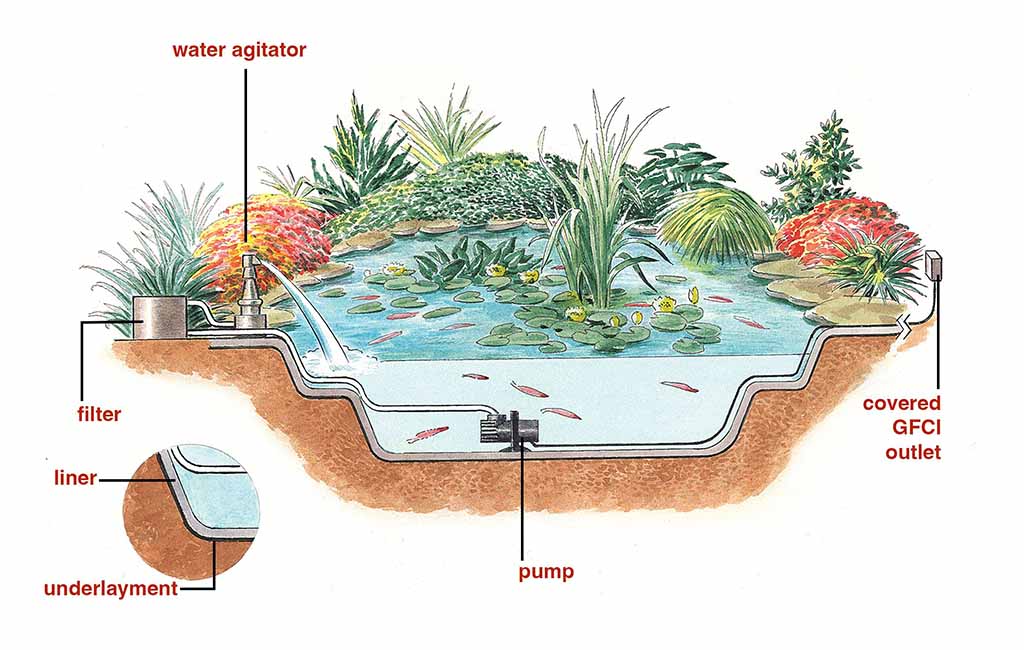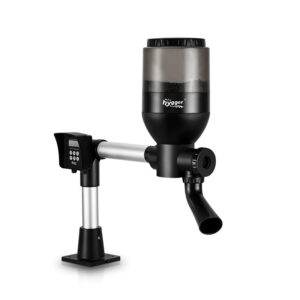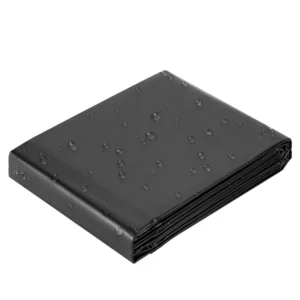When building a small pond with a pond liner in your backyard. It’s easy but requires you to follow a procedure. This article will teach you about what it requires to build a pond, how to build a small pond, and pond liner selection. A step-by-step guide to building a small pond is before the last heading. Moreover, a method to build an inexpensive small pond waterfall is at the end of this article.
Content Table
Prepare for a Small Pond
A small pond feels easy to build, but there are prerequisites to having a sustainable small pond.
Location
Location is the most basic and among the most critical options. Select locations that don’t receive sunlight all day. Day-long sunlight gives rise to algae growth in the pond, which affects the water’s health. There shouldn’t be any trees or shrubs near the pond because they will fill the pond with leaves. However, growing grass will be nice.
There should be some shade in the afternoon. The water table of the pond location should be stable and somewhat deep. It shouldn’t be the drainage point, as it can cause flooding. There should be an electricity source near the pond. It’ll help to run the high flow pump, filter, and other electrical equipment.
Pond Liner
A pond liner is a waterproof and impermeable material sheet that prevents seepage from your pond. Moreover, it acts as a foundation for stable fish and planted ponds. Numerous pond liners are available, e.g., PVC, HDPE, RPE, EPDM, etc. PVC pond liners are usually suitable for small ponds, i.e., a capacity of up to 1000 gallons.
Underlayment
Underlayment is a fiber-woven cloth that acts as a cushion for the pond liners. It helps to avoid accidental punctures in the sheet and avoid tearing. It is necessary when you are growing plants in your pond. It helps to prevent root penetration through the pond liner. Moreover, it helps in rodent protection.
Size and shape of the pond
It’s better to build a pond with various depths, i.e., stairs. With this, you can accommodate multiple types of fish and other aquatic plants and animals. However, avoid digging a deep hole as it is hard to maintain. Up to 2 feet is a manageable depth. Shape your pond in natural ways.
Water Pump
A water pump is one of the essential components of building a small pond. It helps to keep the water in circulation, which helps to avoid algae growth and foul smell from the pond. Moreover, you can also use it to build a small waterfall at the edge of your pond.
It also improves the aeration of the pond, which leads to plant growth and other oxygen-related aspects. Here is one of the top-notch quality pumps.
Filtration
Ponds need efficient filtration as they are open to the atmosphere. Filter selection also depends on the size and bio load of the pond. Select a filter that removes the debris, fish waste, and extra nutrients.

Small Pond with Pond Liner
Soil Type
Although you are using a pond liner as a base for your pond. Despite that, soil type is a vital aspect to consider. Select a location that has more clay content rather than sandy soil.
Water Quality
Water quality is one of the most salient factors that should be optimal. Prepare it before building your pond. It should be dechlorinated and have optimal water quality parameters that meet the fish and botanical species’ demands.
Water Quality Testing Kit
Buy a water quality testing kit. It’ll help you in the long run to keep a close eye on pH, ammonia, and nitrate levels in the pond. It’ll help you to create an optimal and healthy environment for your fish and plants.
Safety
Ensure the safety of the pond. Do have a covering to avoid flooding from rain and other accidental water additions. If you have a child or pets, don’t dig deeper or install a fence to keep the children and pets away from it.
Local Regulations
Check the local authority regulations and safety parameters before planning the pond. Take a permit if you need any.
What Type of Pond Liner Should I Use to Build a Pond
Pond liners help to build a solid foundation for your small pond. Therefore, you should pay extra attention to its selection. Here are some factors that will help you to select a proper pond liner for your small pond.
Types of Pond Liners
Here are some types of pond liners with their advantages and downsides.
| Type | Suitability | Downsides |
| RPE (Reinforced Polyethylene) | Durable Puncture-resistant Fish-safe UV resistant Thinner than other liners |
Relatively stiff expensive Limited lifespan |
| EPDM (Ethylene Propylene Diene Monomer) | Flexible Stretches well Puncture-resistant UV, ozone, and weather resistant Long lifespan (27+ years) Fish safe |
Non-repairable Lower chemical resistance Vulnerable to oil and solvent degradation Expensive |
| HDPE (High-Density Polyethylene) | Chemical resistant Long lifespan, i.e., up to 36 years with good management |
Low flexibility Susceptible to punctures Poor scratch resistance Poor stress cracking resistance |
| LDPE (Low-Density Polyethylene) | Soft Flexible High malleability Easy installation Weldable Suitable for fish |
Low resistance to UV, chemicals, and oxidation than HDPE Weaker in length Expand at high temperatures |
| FPP
(Flexible Polypropylene) |
Flexible Easy molding Tear, scratch, and puncture-resistant Performs well in cold climates (-50°C) |
Vulnerable to hydrocarbons, chlorine, and oils Prone to stress cracking, wrinkles |
| PVC (Polyvinyl Chloride) |
Easy to use Can be installed DIY Long lifespan, i.e., 18-30 years |
Low resistance to UV, ozone, and weathering Prone to degradation Not suitable for extreme temperatures |
| Butyl | Malleable and easy to shape UV, ozone, and weather resistant Performs well in extreme temperatures Fish safe |
Requires adhesive joining Chemically sensitive Physically weak Expensive |
Material Durability
If you want to build a pond that will remain intact for 20+ years, use UV rays, chemicals, and damage-resistant pond liner. RPE, EPDM, HDPE, and Butyl are examples of such pond liner materials. If you want to keep it for 10+ years, PVC or LDPE pond liners will be the best choice.
Pond Size
Plastic or fiberglass pond liners go well with small ponds, i.e., less than 1000 gallons. Moreover, they are easy to install and require no welding. You can use any from the EPDM, PVC, LDPE, Butyl, and Bentonite pond liners. A 50 mm gauge thickness pond liner is suitable for small ponds.
Pond Shape
The shape also impacts the pond liner selection. Here, we are learning about the natural look, so use EPDM or PVC pond liners as they are easy to cut and fit in with the shape.
Environmental Factors
The selection of suitable pond liners also depends on the environmental conditions. You can select with the help of the following table.
| Hot Climate | Cold Climate |
| Resistant to intense sunlight, UV, cracking, and breaking under long sunlight exposure | Flexible and resistant to cracks and leaks in the freeze-thaw cycle |
| EPDM and HDPE | EPDM |
Budget
Budget is one of the key aspects of selecting a suitable pond liner. If you have a high budget, EPDM and HDPE are the best options. However, PVC and LDPE are the on-budget options.
Suggested Pond Liner
If you are designing to build a 500-gallon pond, I suggest using this HDPE hygger Pond Liner with 14.5 mm thickness. It’ll go longer, i.e., up to 30 years.
How to Build a Small Pond?
Building a pond in your backyard takes less and gives a big reward for a long time. Here is a step-by-step procedure for a small backyard pond.
Planing
If you have built your own home, take the underground wiring blueprint to check the underground utilities in your backyard. Otherwise, call some expert to mark the pipes, electrical wires, etc. Plan the size of the pond. It should be a minimal 317 gallons with 7X4X1.5. You can make it deep up to 2 feet. Make a round corner-shaped pond as it gives a natural look.
Digging
The most laborious work in building a pond is to dig the shape. For a proper shape, mark the area of digging with chalk. Dig the hole with the slope, i.e., the deepest in the middle. If you want to grow plants, build stages. Each step should be 1 foot wide and 8 inches deep.
Pond Liner Installation
Spread up to 2 inches of soft builder sand to make the shape uniform. After that, install an underlayment. It will protect the pond liner from punctures. Lay the pond liner that you have selected. It should be 4 feet larger than the pond’s dimensions. You can fold it on the sides. Smooth it in your pond. Use rocks or bricks to fasten it to its place.
Water Filling
Once you have fastened the sheet, slowly fill the pond with the treated water. While filling, get help from some others to gently pull the liner. After filling, install all pond instruments, i.e., pump, filter, fountain, etc.
Ridge Building
Roll the extra pond liner from the sides and cover it with rocks or stones. However, don’t overkill the stones, i.e., extend them only to the water’s edge. It will create a natural look in the pond. You can be creative with these rocks, i.e., follow the size. Leave the gaps between the rocks to grow plants. It’ll help to create a vibrant landscape.
Plants and Fish Addition
Once you are done with the pond, it’s time to select plants and fish. Add plants to the pond. They will improve the oxygenation and help in creating a balanced aquascape. Water lilies, cattails, lotus, water hyacinths, etc, are some options. You can also select aquatic plants according to your region and pond condition. Grow the plants on the terrace you have built, i.e., 1 foot wide and 8 inches deep. Add fish to the pond.
Maintenance
Once you complete the stocking, it’s time to maintain your small yard pond. Frequently remove debris and check the water parameters. Regularly inspect whether the filter is working efficiently or not. If your pond has high sunlight exposure and algae growth issues, add a UV clarifier or algaecide to keep it in its original shape.

How to build a small pond
The Best Way to Build a Small Pond Waterfall
Adding a waterfall to the pond is one of the best things as it enhances the beauty and gives an elegant look to the pond. Moreover, it also improves the aeration of it. Here is the step-by-step procedure for adding a waterfall feature to your pond.
Material
Gather all of the necessary stuff to build. It requires nothing more than a little more investment. Here is a list of some other items.
| Water Pump | Pond liner scraps | PVC pipes |
| Flexible Tubing | Plastic storage bin |
Procedure
-
- Investigate the surroundings of the pond as it requires some height to build a waterfall.
- If the location is slopeless, build an artificial mound with rocks and soil.
- Build a base as it acts like a base of the waterfall. You can use soil, dirt, or rock for the foundation of the mound.
- Install a suitable pump at the deepest point of the pond to power the water flow from the bottom to the top of the waterfall stall.
- Pump selection depends on the size of the pond and the desired flow rate. For small ponds up to 500 GPH water flow is enough.
- Use the flexible tubing to move the water from the bottom of the pond to the top of the waterfall.
-
- Use the rock to decorate and strengthen the waterfall structure. Put the large ones at the bottom and the small ones on it.
- While arranging the stones, ensure to leave some space between the rocks for smooth flow.
- Ensure that the water exactly falls on the smooth surface of the stone.
- Spread a pond liner at the water pathways to properly direct the water flow.
- Install a bucket at the top to control the water flow.
- Run the pump to check the system for potential leaks through piping and check the flow smoothly.
- If you find any weak linkages or rocks, fix them.
- After fixing the issues, give the waterfall a finishing look by hiding the piping.
- Use the extra pond liner, rocks from the pond, and plastic bucket as a spillway.
The Final Word
A small pond brings great happiness in life. It’s easy to construct but requires to put some effort. Select the location, buy the pond liner, underlayment, water pump, and filter, plan it, and prepare optimal parameter water. After shopping, dig a hole, smooth it, spread the underlayment beneath the pond liner, and fill it with water.
After filling, install the instruments, give a finishing look, grow the plants, and stock the fish in your pond. Follow the step-by-step procedure to build an on-budget pond.


Leave a comment